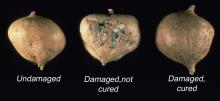Indices de Maturité
Jicama (Pachyrhizus erosus) is a warm season legume root crop. It is also called Yam Bean and is a brown skinned turnip-shaped root eaten raw or cooked. Jicama roots can be harvested at various stages of development. Young tender roots (100-150 g) harvested from green plants are found in specialty markets. Fully mature roots, however, weigh from 250-1500 g. Mature roots are characterized by their size and well-developed periderm as well as their starchy-sweet flavor. To favor hardening of the periderm, plant tops are removed mechanically or irrigation is stopped.
Good quality jicama roots should be smooth and firm, with uniform shape and size, be free from mechanical damage to the skin, and have a crisp, succulent, white sweet-starchy flesh. There are no U.S. Grades for jicama. In Hawaii, however, two grades are recognized based on size and freedom from defects (dirt, discoloration, growth cracks, roughness, insect damage, mechanical injury).
Manipulation et stockage post-récolte
The recommended conditions for commercial storage of jicama are to keep roots cool and dry. Jicama roots are very chilling sensitive and roots should be stored at 12.5°C to 15°C (55°F to 59°F) with moderate relative humidity (70-80%). A storage life of 2-4 months can be expected under these conditions, although stem sprouts will develop after about 2 months. Sprout development results in weight loss and especially a loss of juiciness of the pulp. Minimizing mechanical damage to the periderm during harvest will reduce decay incidence during storage.
| Temperature | 0°C (32°F) |
5°C (41°F) |
10°C (50°F) |
12.5°C (55°F) |
20°C (68°F) |
| ml CO2/kg·hr | |||||
| Mature roots | 2-4 | 5-6 | 5-10 | 2-4 | 3-4 |
| Fresh-cut pieces | 2-4 | 4-6 | 6-10 | - | - |
At 5°C and 10°C (41°F and 50°F) respiration rates increase during storage; rates decrease during storage at temperatures >10°C (50°F). Less mature roots have higher respiration rates.
To calculate heat production multiply ml CO2/kg·hr by 440 to get Btu/ton/day or by 122 to get kcal/metric ton/day.
Jicama is not sensitive to ethylene exposure.
70-80%
Jicama produces only very low amounts of ethylene
No information is available on the potential benefits of controlled atmosphere storage of intact jicama roots. Based on work with other root crops it would not be expected to provide a benefit. On fresh-cut jicama pieces, however, modified atmospheres with 5-10% CO2 reduced decay development and discoloration at 5°C (41°F).
Désordres
Jicama roots are very sensitive to chilling injury at temperatures of 10°C (50°F) or below. Depending on variety and production conditions, roots may develop symptoms of chilling injury in 1 to 3 weeks of storage at 10°C (50°F). No chilling injury is observed on roots stored at 12.5°C (55°F). Decay is the main external symptom of chilling injury, and discoloration and loss of crisp texture are the main internal symptoms. The roots eventually become "rubbery" in texture when severely chilled. Internal discoloration typically occurs from the skin inwards and is more common and more severe in moderately chilled roots (stored at 10°C). At lower temperatures, the pulp will take on a translucent appearance but not necessarily develop brown discoloration; these roots probably also exhibit external decay.
The most common decay organisms found externally on jicama roots are species of Penicillium, Rhizopus, and Cladosporium. Most postharvest decay on jicama is a consequence of mechanical injury and chilling injury.




